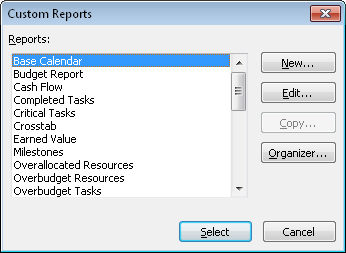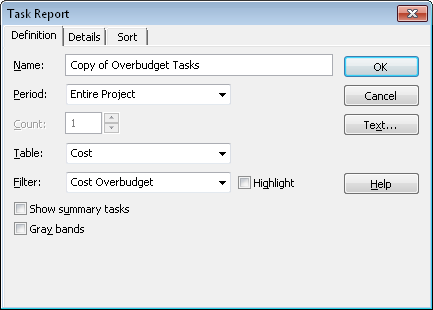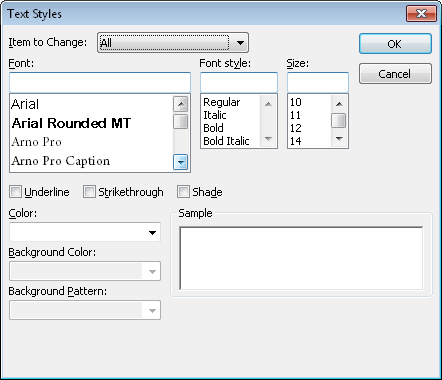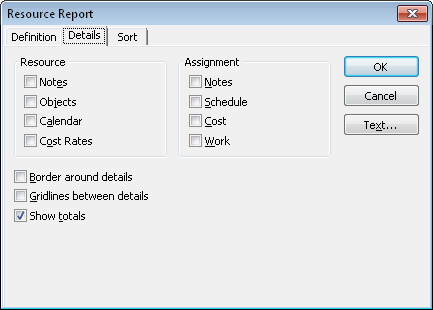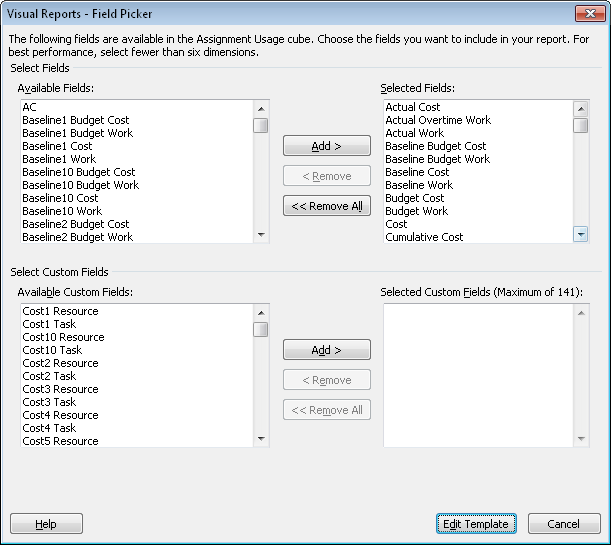After using the standard built-in text and visual reports for several reviews and meetings, you might come up with some new ideas for customizing your presentation and content. You can tweak a built-in report a little (or a lot) to make it better suit your needs. You can either change an existing report or create an entirely new report.
Note
New and modified reports exist only in the current project, by default. If you want to make them available in all your other projects, move the new reports to the project global template by using the Organizer.
Note
For more information, see Sharing Customized Elements Among Projects.
You can create a new text report by basing it on a copy of an existing report, leaving the original version intact. You can directly modify an existing report. You can also change the page layout of a report so that it prints the way you want.
Copying an existing text report and modifying the copy is the easiest and safest method for creating a new report. The original report remains unfettered, and you can feel free to go wild with the copy. It will probably turn out great, but it’s good to know you can experiment without dire consequences. If you get into any trouble, you can always delete the copy and start over again with a fresh copy.
To copy and modify an existing text report, follow these steps:
On the Project tab, in the Reports group, click Reports.
Double-click Custom.
The Custom Reports dialog box appears, as shown in Figure 13-23.
In the Reports box, click the report you want to copy, and then click Copy.
One of three possible dialog boxes appears, depending on the format of the report you’re copying: Task Report, Resource Report, or Crosstab Report. The Task Report dialog box is shown in Figure 13-24.
In the Name box, which shows Copy Of <Report Name>, enter the name of your new custom report.
Be sure it’s a name that’s different from those already in the Reports list.
In the other fields and tabs of the dialog box, make any changes you want to the report content.
Use the Definition tab to set the fields, time periods, and filters to be used. Use the Details tab to specify additional information you want to add to the report. Use the Sort tab to specify which field should dictate the order of information in the report.
Make any changes you want to the report fonts by clicking the Text button.
The Text Styles dialog box appears, as shown in Figure 13-25.
In the Item To Change box, click the report element whose text you want to format, and then specify the changes throughout the rest of the dialog box. Click OK.
When you are finished making changes to your new report, click OK in the report definition dialog box.
The name of your new text report appears in the Reports list in the Custom Reports dialog box.
Click your new report if necessary, and then click Select to generate the report and see what it looks like in the Print Backstage view.
If you want to make further changes, click Project, Reports, Reports. Double-click Custom, select the custom report, and then click Edit.
The report definition dialog box appears again.
Your new report is saved with your project file and is available whenever you work in this particular project.
You can directly edit the definition properties of a built-in text report. The elements available for editing vary by report. In some reports, all you can change is the font. In other reports, you can change the reporting period, filter for specific types of information, specify that information be drawn from a specific table, and more.
When you change an existing report, your changes are saved only with the project file. If you open the same text report in any other project file, the original default report properties will still be present there.
To edit a text report, follow these steps:
On the Project tab, in the Reports group, click Reports.
In the Reports dialog box, double-click the report category you want.
Click the report you want to change, and then click Edit.
One of three possible dialog boxes appears, showing the options available for this report: Task Report, Resource Report, or Crosstab Report. Which one appears depends on the fundamental content and format on which this report is based.
In the other fields and tabs of the dialog box, make the changes you want to the report content or format.
If available, use the Definition tab to set the fields, time periods, and filters to be used. As shown in Figure 13-26, use the Details tab to specify additional information you want to add to the report. Use the Sort tab to specify which field should dictate the order of information in the report.
Make any changes you want to the report fonts by clicking the Text button.
When you are finished editing the report, click OK in the report definition dialog box.
Click the edited report if necessary, and then click Select to generate the report and see what it now looks like in the Print Backstage view.
If you want to make further changes, click Project, Reports, Reports. Double-click the report category, select the modified report, and then click Edit.
The report definition dialog box appears again.
Your new report is saved with your project file and is available whenever you work in this particular project.
You can modify the header, footer, page numbering, and other general page setup elements of a built-in report, a copied report, or a brand-new report. To do this, follow these steps:
On the Project tab, in the Reports group, click Reports.
Double-click the category of the report whose page setup you want to change.
Double-click the report to run it.
The report appears in the Print Backstage view.
Near the bottom of the middle pane of the Print Backstage view, click Page Setup.
Use the options on the Page, Margins, Header, Footer, and other available tabs to make the changes you want.
Note
For more information about page setup options, see Specifying Options for Printed Views.
The changes you make apply to the selected report in the current project and are saved with the project for the next time you need to print this report.
Visual reports are based on report templates that specify the data that’s being drawn from your project file for the report appearing either in Excel or Visio. To modify a visual report or create your own, you can specify the project fields you want to be available in the Excel or Visio report. Then you work in the Excel or Visio report template to specify how those fields are used. When you save the changes to the Excel or Visio report template, those changes are always available for this or other project files.
To edit a built-in visual report template, do the following:
On the Project tab, in the Reports group, click Visual Reports.
Click the built-in visual report template you want to edit.
If you want to change the project fields that are available in the report template, click Edit Template.
The Visual Reports - Field Picker dialog box appears, as shown in Figure 13-27.
Figure 13-27. When you edit a visual report, you specify which fields you want to be a part of the report.
To add fields to the OLAP cube for the visual report, select the fields you want in the Available Fields list, and then click Add. The fields appear in the Selected Fields list.
To remove fields from the Selected Fields list, select the fields, and then click Remove. You can select multiple fields to add or remove by holding the Ctrl key and clicking the fields.
If you changed fields in the Visual Reports - Field Picker dialog box, click the Edit Template button.
If you don’t need to add or remove available fields but want to change other aspects of the visual report, click View.
Either way, Project 2010 builds the OLAP cube for the visual report. Depending on the type of report, Excel or Visio generates the report.
Make the changes you want to the PivotTable in Excel or the PivotDiagram in Visio.
In Excel or Visio, save the template.
The changes you’ve made to the template are saved for future use, replacing the previous version of the template. This modified template is available to any Project 2010 file you use.
Note
For more information, see Configuring a Visual Report in Excel and Configuring a Visual Report in Visio.

